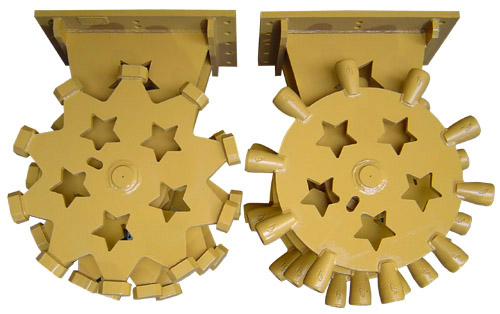Compaction Wheels for skid steers, backhoes and excavators

Pad-Foot (for granular soils) standard equipment. Please specify Sheeps Foot for wet sticky soils (no extra cost).
The mixing and kneading action of the wheel produces a more uniform soil consistency for better compaction. The open-rim design allows maximum penetration through the lift, with standard densities achieved in 6-10 passes under normal soil conditions; the wheel processes the levels of the material as it compacts.
Heavy clay most often can not be torn apart by vibration. The aggressive shearing action of a wheel easily breaks up hard soil and/or clay, so that they can be intermixed into the rest of the fill soil.
You get the same compaction with a fast or slow motion. Speed of travel is critical with vibratory equipment, too little time means poor compaction, while too much is inefficient. Six to eight passes usually produce the required densities, in less time than the same compaction with a vibratory compactor. Wheels do more with less wear and tear on the operator and machine.
Vibration from vibratory machines can loosen joints in water, gas, and sewer lines as well as damaging nearby slabs, foundations, or electrical/electronic equipment. This is not a problem with the smooth operation of a compaction wheel.
Equipmentland prices are better than buying direct from Manufacturer.






